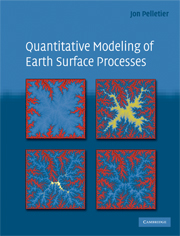Book contents
- Frontmatter
- Contents
- Preface
- Chapter 1 Introduction
- Chapter 2 The diffusion equation
- Chapter 3 Flow routing
- Chapter 4 The advection/wave equation
- Chapter 5 Flexural isostasy
- Chapter 6 Non-Newtonian flow equations
- Chapter 7 Instabilities
- Chapter 8 Stochastic processes
- Appendix 1 Codes for solving the diffusion equation
- Appendix 2 Codes for flow routing
- Appendix 3 Codes for solving the advection equation
- Appendix 4 Codes for solving the flexure equation
- Appendix 5 Codes for modeling non-Newtonian flows
- Appendix 6 Codes for modeling instabilities
- Appendix 7 Codes for modeling stochastic processes
- References
- Index
- Plate section
Chapter 3 - Flow routing
Published online by Cambridge University Press: 05 June 2012
- Frontmatter
- Contents
- Preface
- Chapter 1 Introduction
- Chapter 2 The diffusion equation
- Chapter 3 Flow routing
- Chapter 4 The advection/wave equation
- Chapter 5 Flexural isostasy
- Chapter 6 Non-Newtonian flow equations
- Chapter 7 Instabilities
- Chapter 8 Stochastic processes
- Appendix 1 Codes for solving the diffusion equation
- Appendix 2 Codes for flow routing
- Appendix 3 Codes for solving the advection equation
- Appendix 4 Codes for solving the flexure equation
- Appendix 5 Codes for modeling non-Newtonian flows
- Appendix 6 Codes for modeling instabilities
- Appendix 7 Codes for modeling stochastic processes
- References
- Index
- Plate section
Summary
Introduction
Digital Elevation Models (DEMs) play an important role in modern research in Earth surface processes. First, DEMs provide a baseline dataset for quantifying landscape morphology. Second, they enable us to model the pathways of mass and energy transport through the landscape by hillslope and fluvial processes. Given the importance of DEMs in a broad range of geoscientific research, the ability to digitally process DEMs should be a part of every geoscientists' toolkit.
Flow-routing algorithms lie at the heart of DEM analysis. Flow-routing algorithms are used to model the pathways of mass and energy through the landscape. There is no unique flowrouting method because different constituents move through the landscape in different ways. Water, for example, moves through the landscape somewhat differently than sediment. Also, flowrouting models are necessarily simplified models of transport. Indeed, the only ideal model for water flow in the landscape is the full solution to the Navier–Stokes equations of fluid dynamics. Modeling the Navier–Stokes equations in a complex topographic environment, however, is beyond the scope of any computer. As such, all flowrouting methods involve some approximation to the real physics of mass and energy transport. The key, then, is to develop a suite of flow-routing algorithms that partition mass and energy down-slope in ways that mimic the complex processes of actual fluid flow. Modelers can then choose which algorithm represents the best compromise between realism, computational speed, and ease of use.
Information
- Type
- Chapter
- Information
- Quantitative Modeling of Earth Surface Processes , pp. 66 - 86Publisher: Cambridge University PressPrint publication year: 2008
